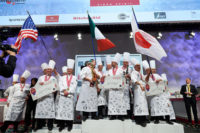Crème de la Candy
Premium confections are not just for the rich and famous anymore; now, the category is getting rich and famous thanks to more indulgent everyday consumers.
In spite of the economy,
most Americans are getting a lot richer—in their choice of gourmet
candy and chocolates, that is. The trend has been recently recorded in
other consumable markets as well. Packaged Facts has reported that in
addition to premium chocolates, gourmet coffee, upscale ready-to-drink
beverages/bottled waters, and super-premium ice creams are all growing at a
faster pace than their mainstream counterparts.
Gourmet/premium chocolate is especially attractive to
today’s health-conscious consumers thanks to the industry touting the
health benefits of its higher-cocoa, lower-sugar content and antioxidant
properties, especially compared to other snacks and treats.
If you couple that news with the increasing consumer
urge to have an affordable luxury item—even in down times—it
becomes clear why the category is doing so fine.
Imperatives
Premium/gourmet candy deserves a lot of fanfare and
attention. Too often, retailers with space limitations are squeezing it in
with mainstream candy. That is not the best way to max out this growing
category. While it can have a spot or two in the regular candy section, it
is truly the impulse purchase of impulse purchases, and deserves some air
space around it. Atop a display in the gourmet deli section, on a seasonal
endcap, near a rack of upscale greeting cards, in a display basket on the
cosmetics counter, in an upscale, seasonally themed window
display—these and many more options that a retailer can come up with
depending on its own unique merchandising and layout techniques, will
showcase it better than on a crowded candy shelf. This is the Cadillac of
candy—retailers should treat it as such.
And this is true no matter what the price, which is
another important point to note: the upscale confection category has come
down a bit in price points to satisfy the consumer’s overwhelming
response to smaller bites of self-gifting candy. Gourmet candy items that
are five dollars and under are now a mainstay of the category.
Change-makers are even available for 99 cents. But retailers should not
confuse these with more typical candy items. They are still to be
merchandised as the premium items that they are.
Consumers
Gourmet candy has baby boomer written all over it.
Gourmet boxed chocolates, specialty dark chocolates, organic, and
functional chocolates/confections (focusing on adult issues of health
concerns and the environment) fulfill this still desirable consumer
market’s comfort factor and concerns as they gray; while still
appealing to their “I’m worth it” attitude.
But they are not the sole special ones. Young
professionals and trendsetters, particularly professional, educated women
over age 22, have been recently targeted by upscale candy manufacturers.
Adjacencies
Where do you not put gourmet confections? With gourmet
foods showing up in the strangest, yet successful places—such as car
wash counters where customers go to pay—retailers are limited only by
their pre-conceived notions of where upscale candy should go within their
stores. The most important point to remember is that consumers are pressed
for time—especially those looking for quick ways to treat themselves
while they run errands. The same customer that might only buy a suit at
Nordstrom’s is now very accustomed to buying upscale consumables at
the grocery store, and yes, even the car wash. So go crazy with it. See
what happens when you put a dangler of upscale chocolate packages in the
automotive department. Chances are, many will bite.
Seasonality
Candy-giving holidays used to be the prime times to
promote gourmet and premium confections. But now with more consumers
indulging in the category on a regular basis, that thinking is no longer a
good retail strategy. Sure, there is seasonality to the larger gift boxes
and baskets of premium sweets; but it has practically vanished in the
smaller sizes that have become most popular today.
A much more effective and slowly emerging trend is to
use the Farmer’s Market concept and apply it to seasonal
merchandising opportunities in gourmet candy. More dried fruits and nuts,
for instance, will be well-marketed in the fall and winter, while cherry
and lemon candies will do best in the summer.
Outlook
American chocolatiers are moving up in status. Many
claim that they can make premium chocolate as well as that of any European
country. Perhaps even better, they have become masters of putting an
American spin on their upscale confection concoctions—such as
targeting the American female chocolate consumer with tongue-in-cheek
packaging, and playing up “girlie” images and wrappings to this
very professional group, which has turned out to be just confident and
secure enough in their careers and status to love the more feminine focus.
Expect the category to become even more fine-tuned. For
instance, pairing fruit with chocolate has been well-received in recent
years, but it was indiscriminate; in the near future it is expected that
only the best fruit flavors, such as raspberry and orange, will be included
in an upscale line. The wilder flavors, such as pear, will probably fall by
the wayside. It is also expected that extremely hot and spicy flavors, such
as those that are often more ethnic-appealing, will be replaced by more
comforting notes of cinnamon and nutmeg. The bizarre, really obscure
flavors will probably fall away. In its place—sweet and salty will
gain as a popular confectionery combo.
Organics are expected to play more of a role in the
chocolate side of gourmet candy; while new mint items and
“tasting” wafers” will dominate the non-chocolate side of
things. n
The U.S. Market for Gourmet Chocolate
Overall sales in the segment have been on the
rise in recent years, growing to $243 million at retail in 2003, the latest
sub-segment figures.
69% of Americans agree that rich, dark
chocolate is an upscale, indulgent alternative to standard off-the shelf
chocolate varieties.
The category still has plenty of room for
growth if it’s to catch up to its European counterparts; in
Switzerland per capita consumption of upscale chocolate is twice that of
the American consumer.
80% of chocolate consumers prefer portion
control pieces; portion control and gourmet candy desires were found not to
be mutually exclusive.
Source: Packaged Facts
Merchandising Musts
Think warehouse clubs.
The warehouse club sector gets a lot of credit for getting the gourmet/premium candy category off its feet in this country as a more mainstream confection. Other retail sectors would be wise to copy some of the successful tactics from this channel, namely: featuring limited edition gourmet items every year, gearing up for holiday seasons with holiday-appropriate oversized gourmet gift treats, offering upscale candy gift certificates (pre-packaged by the retailer) as a line extension for customers who want to give upscale treats without knowing exactly what the recipient likes, and sampling gourmet candy during high traffic times, such as weekends before a major gift-giving holiday (Christmas and Hanukkah, Mother’s Day, Valentine’s Day, etc.)
The warehouse club sector gets a lot of credit for getting the gourmet/premium candy category off its feet in this country as a more mainstream confection. Other retail sectors would be wise to copy some of the successful tactics from this channel, namely: featuring limited edition gourmet items every year, gearing up for holiday seasons with holiday-appropriate oversized gourmet gift treats, offering upscale candy gift certificates (pre-packaged by the retailer) as a line extension for customers who want to give upscale treats without knowing exactly what the recipient likes, and sampling gourmet candy during high traffic times, such as weekends before a major gift-giving holiday (Christmas and Hanukkah, Mother’s Day, Valentine’s Day, etc.)
Play up portion-control.
A recent gourmet chocolate study reported by Packaged Facts found that easy-open/re-sealable, portable, single-serve packaged for the confectionery market is a growth market because it provides extra convenience for impulse and grab-and-go eating. It was also noted that another growth market is smaller, bite-size candies that ease second thoughts about consumption: people who would never eat several candy bars in one day might much more readily eat several bite-size chocolates. Therefore, the trend towards miniaturization and the trend towards more premium and indulgent candies are not mutually exclusive. Retailers need to showcase their offerings in petite premiums.
A recent gourmet chocolate study reported by Packaged Facts found that easy-open/re-sealable, portable, single-serve packaged for the confectionery market is a growth market because it provides extra convenience for impulse and grab-and-go eating. It was also noted that another growth market is smaller, bite-size candies that ease second thoughts about consumption: people who would never eat several candy bars in one day might much more readily eat several bite-size chocolates. Therefore, the trend towards miniaturization and the trend towards more premium and indulgent candies are not mutually exclusive. Retailers need to showcase their offerings in petite premiums.


